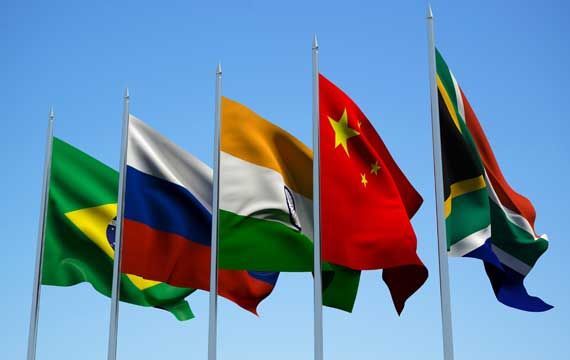In August, six more countries – Argentina, Saudi Arabia, the United Arab Emirates, Egypt, Ethiopia and Iran – agreed to join BRICS by 2024, hence the term BRICS More. (Photo: Shutterstock)
GEOPOLITICAL ANALYSIS. Since 1945, the downgrading of the United States and the West has been repeatedly incorrectly predicted. In the 1950s, the former Soviet Union had to “bury” capitalism. In the 1980s, analysts claimed that the Japanese economy would one day overtake that of the United States. In the 2010s, the mantra was that China would become the first economic power. Today, it is the BRICS Plus which would be destined to reshape the international order.
Founded in 2009, BRICS includes Brazil, Russia, India, China and South Africa, which joined in 2010. As of August, six more countries – Argentina, Saudi Arabia, United Arab Emirates, Egypt, Ethiopia and Iran – agreed on join BRICS by 2024hence the term BRICS Plus.
However, caution is advised with this type of forecast regarding BRICS Plus so as not to succumb to the geopolitical “flavor of the month”, as analysts have often been wrong in the past:
- Not only did the former Soviet Union and communism not have “ Capitalism was buried (as leader Nikita Khrushchev said in 1956), but they collapsed in the early 1990s – at least in Europe, because of communism.
- The Japanese economy has never surpassed that of the United States. Since the bursting of Japan’s housing bubble in 1990, the Japanese economy has remained stagnant or relatively sluggish, and has become a shadow of its former self.
- Companies, such as Goldman Sachs, which claimed that China would overtake the United States to become the leading economic power in the 2020s, are now delaying this deadline. And some companies, like Capital Economics, even claim that it will never happen because China has too many problems.
Of course, an inadequate reading of the situation regarding BRICS Plus has no real impact in the short and medium term on Canadian companies active in international markets.
On the other hand, in the long term, over a horizon of 10 to 25 years for example, overestimating the impact of BRICS expansion on the economy and international relations could potentially lead to bad decisions.
For example, turning our back on some promising Indo-Pacific markets on the grounds that the expected rise of BRICS Plus would lead to a decline in democracy and the rule of law in some parts of the world.
Half the population, a third of the GDP
The aim of BRICS Plus is to give a stronger voice to the countries of the South – a heterogeneous collection of non-aligned countries – and thus to exert greater influence on the world stage, still dominated by the United States and the West. In short, contribute to creating a new multipolar international order where Westerners would only be involved in the “management” of the world.
It is difficult to oppose this principle of more collegial management of the world, as long as this does not lead to a decline in human rights and democracy on the planet.
One thing is certain, the BRICS Plus member countries have considerable weight on the international scene.
Incorporating Argentina, Saudi Arabia, the United Arab Emirates, Egypt, Ethiopia and Iran, the group will be home to 46% of the world’s population and will also account for just over a third of its GDP. in the world, reports the French newspaper World.
To put things in perspective, what we call the West (basically Canada, US, EU, UK, Switzerland, Norway, Iceland, Australia and New Zealand) Zeeland) represents about 10% of the world’s population, but about half of the world’s population. of global GDP, according to data from the International Monetary Fund and the World Bank.
In short, the BRICS Plus have demographic weight, while the West has economic weight.
The structural weaknesses of BRICS Plus
As influential as they are, the BRICS countries do not have – at least for the moment – the coherence that Western countries can have thanks to the organizations and treaties which bind them together and which are guarantees of power. and influence.
The British magazine The Information Statesman give some examples.
- BRICS Plus does not have a regional free trade agreement whichCanada-United States-Mexico Agreement (CUSMA).
- The BRICS Plus do not have a military alliance like the North Atlantic Treaty Organization (NATO).
It can be added that Western countries also have the distinction of being liberal democracies, where the rule of law and freedom of the press are generally the norm.
That said, there may be exceptions in countries like Poland or Hungary, two EU member states ruled by a radical, anti-liberal right.
On the other hand, the BRICS Plus countries do not demonstrate such political and cultural coherence.
For example, India, Brazil, Argentina and South Africa are democracies, while the other countries are either authoritarian regimes or dictatorships.
There is another factor to consider in the context of BRICS Plus: China’s demographic decline will eventually weaken its economic potential and therefore its political and military influence more and more.
However, China is considered the leader of the group.
China’s population will decline by several hundred million by 2100, according to two Chinese organizations. (Photo: Getty Images)
China’s population will decline in the 21st century
Little known fact, China’s population of 1.4 billion began to decline in 2022.
Here are two forecasts that give an idea of the scale of this phenomenon.
The United Nations (UN) predicts that by 2100, China’s population will fall to 767 million. The Shanghai Academy of Social Sciences, for its part, predicts a more critical scenario, with a drop to 587 million.
On the other hand, in 2100, the United States should have 394 million inhabitants (332 million today), according to the United Nations.
Finally, two last elements must be considered to understand that the BRICS Plus are not about to downgrade the rating of the United States and the West in the near future.
On the one hand, India, the second economic and demographic giant of the world, is not hostile to the West, even if this country has for example a neutral position with regard to the conflict in Ukraine – it even buys Russian oil.
India is notably part of the QUAD (Quadrilateral Security Dialogue), an alliance formed by the United States, India, Japan and Australia. Founded in 2007, it aims to contain the rise of China to ensure stability in the Indo-Pacific, a vast region that encompasses the Indian Ocean and the Pacific Ocean.
He who controls the oceans controls the world
On the other hand, the United States – an economic, political, cultural, technological, military and demographic power – controls and will control for the foreseeable future the Pacific and Atlantic oceans, in particular through its allies in Europe and in the Indo-Pacific. . , including South Korea, Japan, Australia and India.
However, the power that controls these two oceans can control the international economy, underlines George Friedman, the author of 100 years ahead: a scenario for the 21st century (ZLD Éditions, 2013) and founder of the geopolitical analysis and business intelligence company Stratfor.
The emergence of BRICS Plus will be a trend that will structure our century at the geopolitical level.
The West will have to learn to share more power and influence in the world, to better take into account the diversity of humanity.
And we repeat, this is a good thing.
That said, analysts who predict or wish for a downgrade of the US and other Western nations on the world stage may be disappointed.
The West is likely to remain the main center of power and influence in the world for a long time to come.

“Devoted reader. Thinker. Proud food specialist. Evil internet scholar. Bacon practitioner.”







